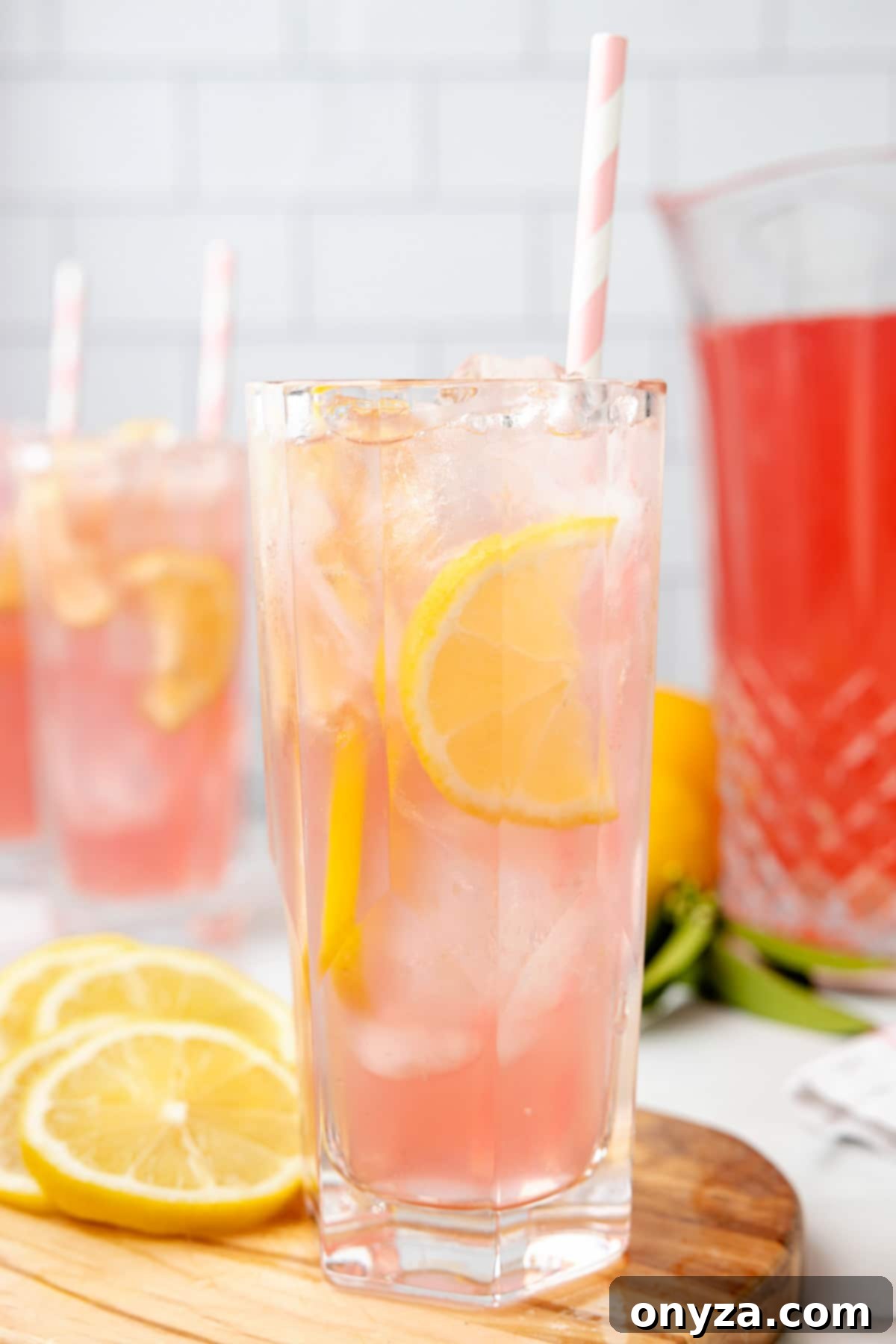Welcome to the ultimate guide for crafting the most delightful Pink Lemonade right in your own kitchen! Forget the store-bought versions; homemade offers a vibrant, refreshing taste that truly captures the essence of summer. With just a handful of simple ingredients, many of which are likely already in your pantry, you can whip up a pitcher of this sweet-tart beverage. Its charming pastel hue makes it perfect for any occasion, from relaxed backyard picnics and sunny brunches to elegant wedding and baby showers, or simply as a delightful everyday treat.
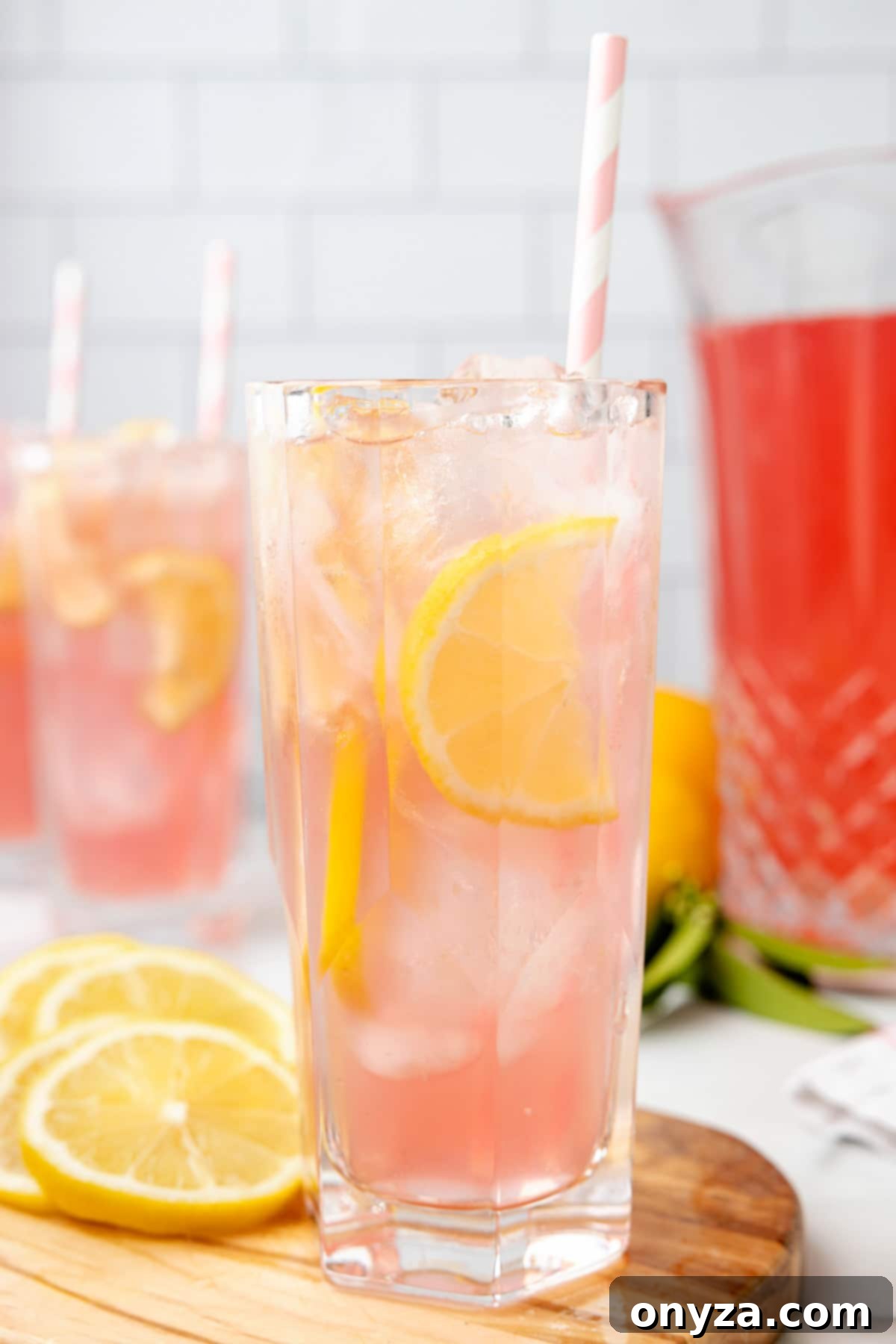
This article may contain affiliate links. As an Amazon Associate, I earn a commission (at no additional cost to you) from qualifying purchases made by clicking these links. Rest assured, all recommendations and opinions expressed are genuinely my own.
The Allure of Pink Lemonade: More Than Just a Drink
Pink lemonade holds a special place in our hearts. It’s more than just a beverage; it’s a symbol of sunny days, joyful gatherings, and refreshing simplicity. Its delicate color instantly evokes feelings of warmth and festivity, making it a staple for spring and summer celebrations. The beauty of making it at home is the complete control you have over its flavor profile and, crucially, its beautiful pink shade. You can adjust the sweetness, the tartness, and the depth of color to perfectly suit your preferences, ensuring a truly personalized and delightful drinking experience.
A Sip Through Time: The Curious Origins of Pink Lemonade
Have you ever wondered about the intriguing history behind pink lemonade? While its origins are debated, one of the most captivating tales takes us back to the 19th-century American circus. Legend has it that a lemonade vendor, struggling during a hot performance, accidentally dropped red cinnamon candies into his lemonade. Or, perhaps less appetizingly, he ran out of water and used dirty wash water that a performer had used to rinse her pink tights! Despite the questionable beginnings, the distinctive pink hue caught on, transforming a simple drink into a whimsical sensation. For a fascinating deep dive into its past, be sure to check out The Unusual Origins of Pink Lemonade from Smithsonian Magazine.
The Secret Behind the Hue: Natural Coloring for Homemade Pink Lemonade
While many commercial pink lemonades rely on artificial food dyes to achieve their signature color, one of the greatest joys of homemade lemonade is coloring it naturally. This recipe primarily uses cranberry juice or a cran-raspberry blend to impart a beautiful, light pastel pink. This method not only avoids artificial additives but also subtly enhances the flavor profile, adding a hint of fruity complexity that complements the tart lemon.
But cranberry isn’t your only option! The world of natural colorants for pink lemonade is wonderfully diverse. Consider experimenting with other fruit juices or purees to discover your favorite shade and flavor combination:
- Pomegranate Juice: Offers a deeper, richer pink with a slightly tart and earthy flavor.
- Red Grape Juice: Can provide a lovely rose-pink color, often adding a sweeter, more robust grape note.
- Red Raspberry Juice or Puree: Delivers a vibrant, true pink and a wonderfully sweet, intense berry flavor. When using a puree, remember to strain it for a smooth consistency.
- Strained Watermelon Puree: Creates a lighter, delicate pink and a wonderfully refreshing, sweet melon essence, perfect for peak summer.
- Strawberry Puree (strained): Provides a classic pink and a sweet, juicy strawberry flavor that pairs perfectly with lemon.
When substituting different juices or purees, remember to adjust the amount of granulated sugar accordingly. Juices like red raspberry or watermelon are naturally sweeter, meaning you’ll need less added sugar in your lemonade base. Always taste and adjust to achieve your perfect balance of sweet and tart.

Crafting Your Perfect Pitcher: Essential Ingredients for Homemade Pink Lemonade
Making delicious homemade pink lemonade is incredibly straightforward, requiring only a few key components. Here’s a closer look at the ingredients that form the heart of this refreshing beverage, ensuring a balanced and flavorful outcome:
- Freshly Squeezed Lemon Juice: This is the soul of any great lemonade. For the brightest, most authentic flavor, absolutely nothing compares to freshly squeezed lemon juice. Bottled varieties often contain preservatives or lack the vibrant zestiness that fresh lemons provide. You’ll typically need about 4 to 6 medium to large lemons to yield one cup of juice, but this can vary based on their size and juiciness. We’ll cover tips for efficient juicing in the next section.
- Granulated Sugar: Regular granulated sugar is ideal for this recipe as its fine crystals dissolve effectively in the acidic lemon juice without requiring heat. The recipe provides a range for the quantity, allowing you to customize the sweetness to your liking. Your personal preference for sweetness, along with the natural sweetness (or tartness) of the cranberry juice you choose, will guide the final amount. For a slightly smoother dissolve, superfine sugar can also be used, though it’s not strictly necessary.
- Water: The quality of your water significantly impacts the final taste of your lemonade. I highly recommend using filtered or spring water to avoid any unwanted tap water flavors like chlorine. For an exciting twist, consider substituting a portion or all of the still water with chilled sparkling water or seltzer just before serving. This creates a delightful fizzy pink lemonade that’s perfect for a celebratory feel.
- Cranberry Juice: This is our star ingredient for achieving that lovely pink hue. You have options here: sweetened or unsweetened cranberry juice. If opting for unsweetened 100% pure cranberry juice, be prepared to add a bit more sugar to balance its intense tartness. Many popular cranberry juice cocktails and cranberry juice blends (even those labeled “100% juice”) are already sweetened, which will affect the amount of sugar needed. My family particularly enjoys using cranberry juice blends, especially Cran-Raspberry, for its enhanced color and slightly sweeter berry notes.
Curious about the cranberry juice aisle? The variety can be confusing! Dive into the differences between cranberry juice and cranberry juice cocktail with this helpful article from Kitchn: What’s the Difference Between Cranberry Juice and Cranberry Juice Cocktail?
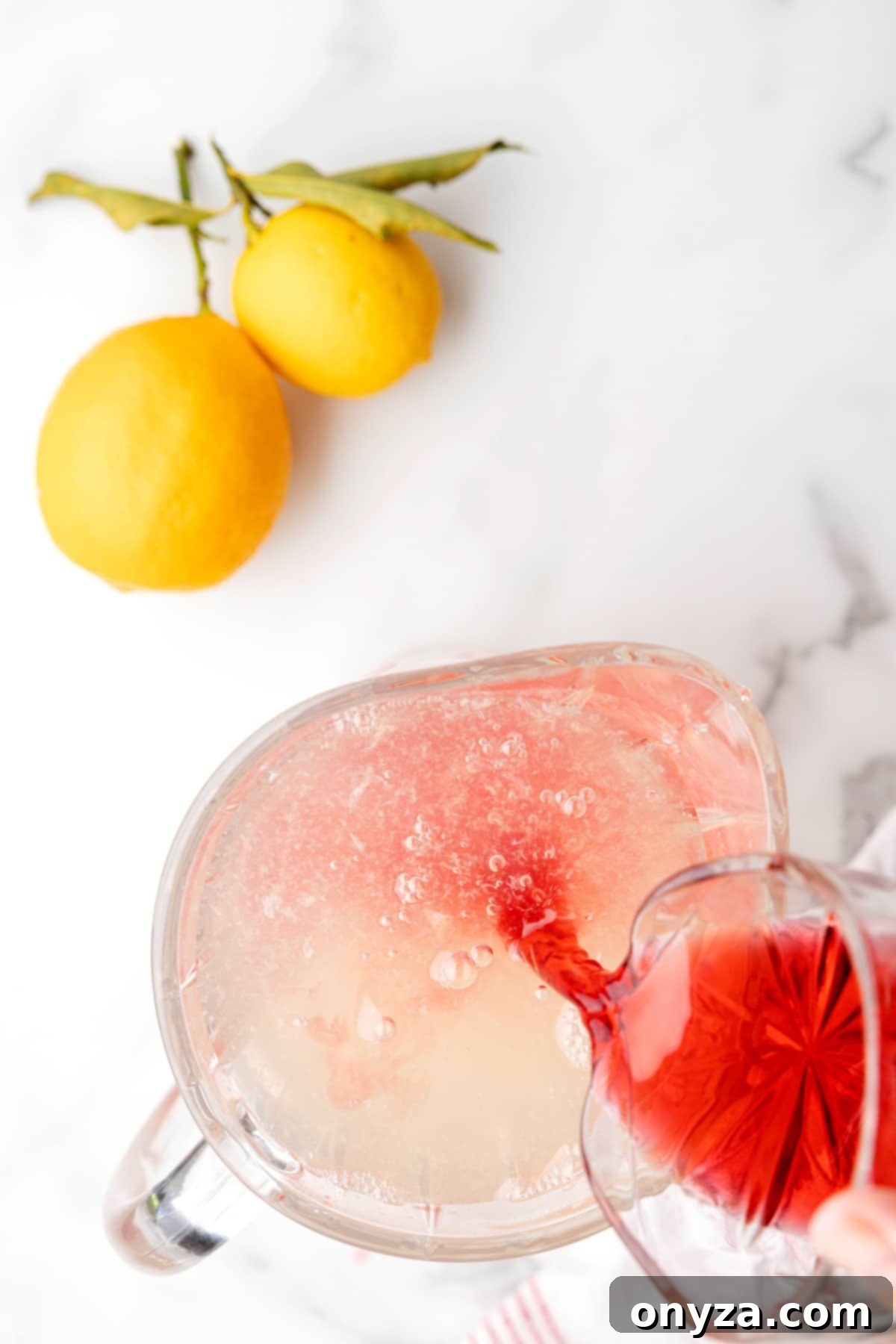
Mastering the Art of Homemade Pink Lemonade: Pro Tips for Perfection
Juicing Your Lemons for Maximum Yield
To extract the most juice from your lemons, a few simple techniques can make a big difference. Before cutting, roll the whole lemons firmly on your countertop with the palm of your hand. This action helps to break down the internal membranes, releasing more juice when squeezed. For ultimate efficiency, I highly recommend a handheld manual lemon juicer. Its design is incredibly effective at pressing out every last drop and often catches seeds, making the process quick and mess-free. If you’re using a traditional citrus juicer or a simple reamer, the rolling technique is even more beneficial.
Once juiced, ensure all seeds are removed. When it comes to pulp, the choice is yours! My family enjoys the textural element a little pulp adds, so I often leave it in. However, if you prefer a perfectly smooth lemonade, simply strain the lemon juice through a fine-mesh sieve before mixing.
Effortless Sugar Dissolution Without Heat
Many lemonade recipes call for making a simple syrup by heating sugar and water on the stove to ensure the sugar fully dissolves. While effective, this extra step isn’t always necessary for homemade lemonade. I’ve found that granulated sugar dissolves beautifully when combined directly with acidic lemon juice and given a little time and agitation.
My preferred method is to combine the sugar and freshly squeezed lemon juice directly in your serving or storage pitcher. Whisk vigorously for about a minute, then let the mixture rest for approximately 5 minutes. This brief pause allows the acid in the lemon juice to begin breaking down the sugar crystals. After resting, whisk thoroughly once more. You’ll find the sugar will be almost, if not entirely, dissolved, saving you the hassle of heating and cooling a syrup.
In search of the perfect pitcher? For refrigerator storage, we adore the Bormioli Rocco Hermetic Seal Glass Pitcher. If serving outdoors or poolside, a BPA-free shatterproof pitcher is a practical and safe choice.
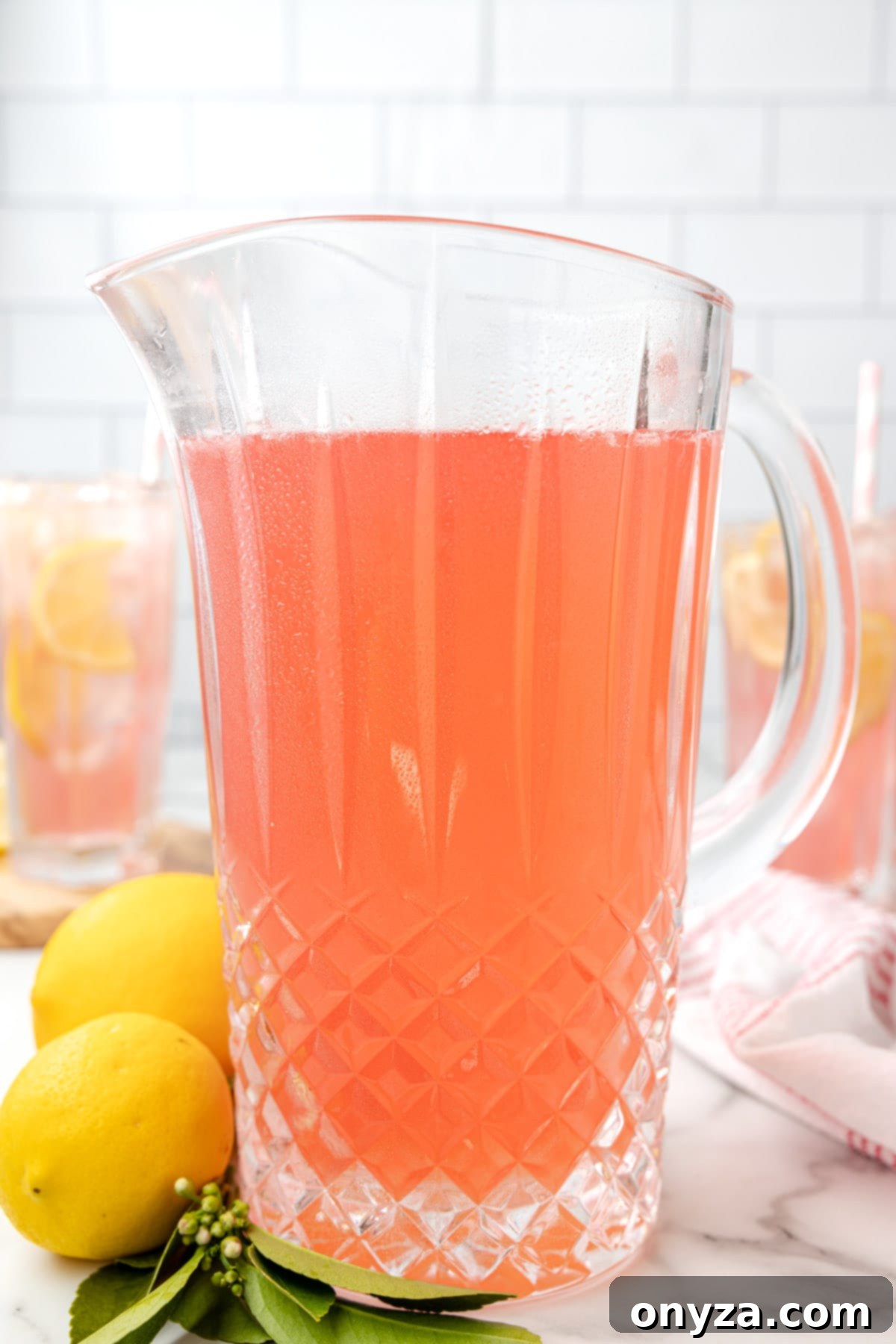
Achieving the Ideal Pink Shade: Choosing Your Cranberry Juice
The type and brand of cranberry juice you select will directly influence the final color of your pink lemonade. Plain cranberry juice typically yields a lovely pastel, somewhat peachy-pink shade. Some brands might be more vibrant than others, so don’t hesitate to experiment with a few to find your preferred tone.
If you’re aiming for a cooler, more distinctly “pink” pink lemonade, I highly recommend using a Cran-Raspberry juice blend. The addition of raspberry (and sometimes grape juice in these blends) introduces richer red tones, resulting in a deeper, more vibrant pink hue. Fun fact: Cran-Raspberry is a hands-down family favorite for its beautiful color and delightful taste!
It’s important to remember that the lemonade mixture will appear more vibrant in the pitcher than it will once poured into ice-filled glasses. Ice dilutes the color slightly, so don’t be alarmed if it looks a little less intense in your cup. Personally, I avoid adding excessive cranberry juice just to deepen the color, as it can start to overpower the refreshing lemon flavor. For a truly vibrant pink without compromising taste, consider stirring in a teaspoonful of grenadine or even maraschino cherry juice. These options offer concentrated color with minimal flavor impact.
Customizing Water Levels to Your Taste
The optimal amount of water for pink lemonade is a matter of personal preference, and it can even divide a room! Some prefer a slightly more concentrated base, particularly because ice in the serving glass will further dilute the drink. For this preference, starting with 4-1/2 cups of water for the full recipe is ideal. This allows the lemonade to be potent enough to stand up to melting ice.
Others prefer a milder lemonade from the start, opting for 5 cups of water in the pitcher. My suggestion is to begin with 4-1/2 cups of chilled filtered water. Once the base is mixed and chilled, taste it and then gradually add more water, a quarter cup at a time, until you reach your desired concentration. This allows for perfect customization.
Chilling for Perfection: Serving Your Refreshing Pink Lemonade
After mixing, chilling your pink lemonade is a crucial step for optimal flavor. Allowing it to chill in the refrigerator for at least an hour (or longer if possible) allows the flavors to meld beautifully and ensures a wonderfully refreshing, cold drink. When ready to serve, fill tall glasses generously with ice. Garnish each glass with fresh lemon slices or wedges for an elegant touch. For a truly party-perfect presentation, consider adding light pink paper straws. Remember, it’s best to add ice directly to individual glasses rather than to the pitcher. This prevents the entire batch of delicious lemonade from becoming watered down as it sits.
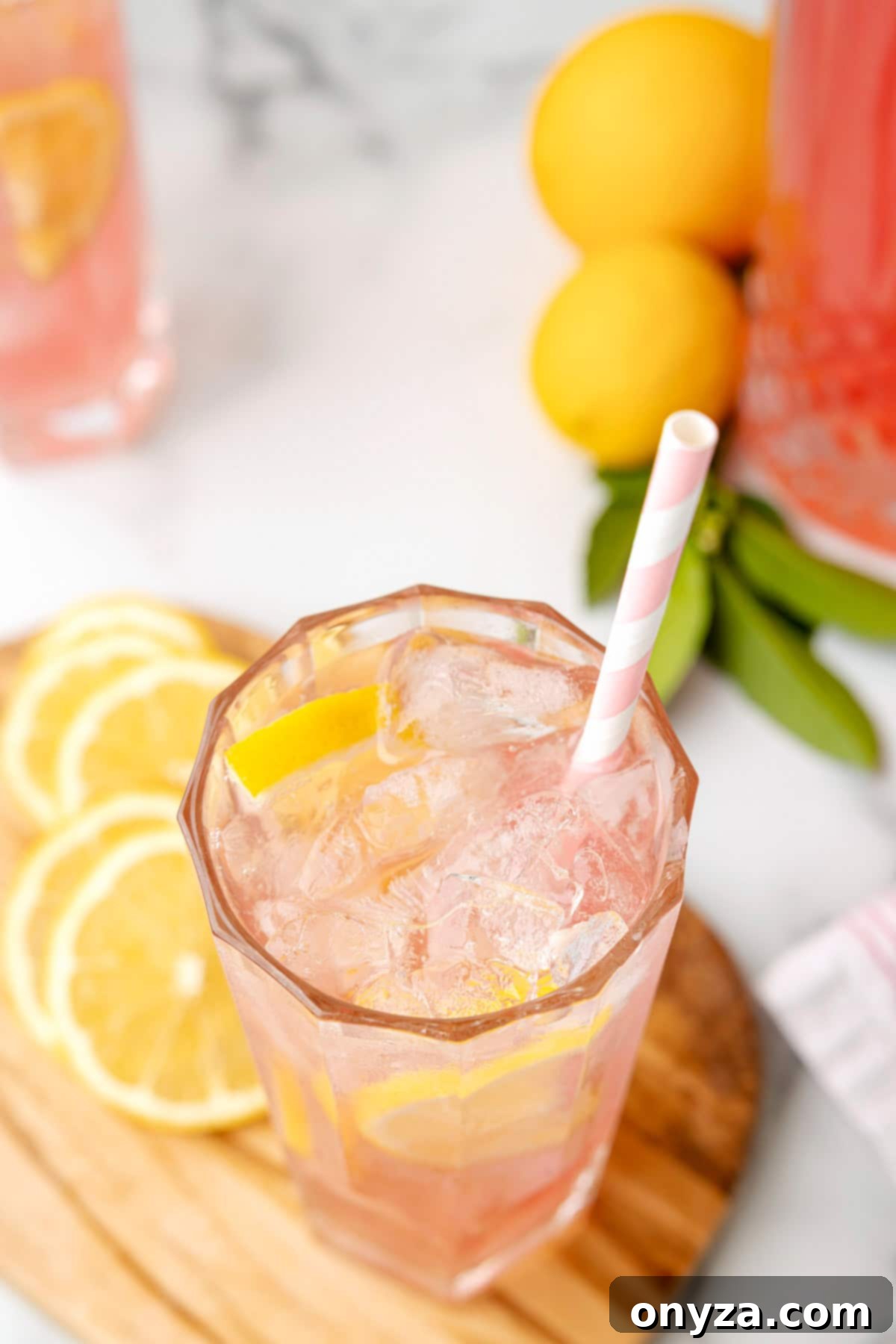
Storing Homemade Pink Lemonade for Lasting Freshness
One of the many advantages of homemade pink lemonade is its excellent shelf life in the refrigerator. Store any leftover lemonade in a covered pitcher or, for a charming bistro-like presentation and convenient grab-and-go options, in flip-top glass bottles. Properly stored, your pink lemonade will remain fresh and delicious for up to 4 days. Before pouring, give the capped bottle a gentle shake or stir the lemonade in the pitcher to redistribute any settled pulp or flavors.
Beyond the Classic: Exciting Pink Lemonade Variations
Once you’ve mastered the classic pink lemonade, consider these exciting variations to keep things fresh and fun:
- Herb Infused: Add fresh mint leaves or basil to the pitcher during chilling for an aromatic twist. Lightly muddle the herbs to release their essential oils.
- Berry Blast: Muddle fresh strawberries or raspberries into the lemon juice before adding sugar for an intensified berry flavor and a deeper pink.
- Sparkling Delight: As mentioned, replace still water with chilled sparkling water or club soda for a fizzy, festive drink perfect for celebrations.
- Spiked Pink Lemonade: For adult gatherings, add a splash of vodka, gin, or white rum to individual glasses for a delightful cocktail.
- Ginger Kick: Infuse a few slices of fresh ginger during the chilling process for a subtle, warming spice note.
Why Homemade Trumps Store-Bought: The Benefits of Crafting Your Own Pink Lemonade
Opting for homemade pink lemonade offers numerous advantages over its store-bought counterparts. First and foremost, you gain complete control over the ingredients. This means no artificial flavors, colors, or excessive high-fructose corn syrup – just pure, natural goodness. You can adjust the sweetness to your exact preference, catering to those who prefer it extra tart or wonderfully sweet. Freshly squeezed lemon juice provides a superior, brighter flavor that pre-made mixes simply cannot replicate. Furthermore, making it at home is often more cost-effective, especially when lemons are in season. It’s also a rewarding culinary experience, allowing you to create a personalized, refreshing drink that truly shines.
More Refreshing Spring and Summer Drink Recipes
If you’re looking for other delightful beverages to cool down on warm days, explore these fantastic options:
- Strawberry Basil Soda
- Strawberry Mojito
- Mimosa Mocktail
- Blackberry-Lemon Mint Juleps
CRAVING MORE? Subscribe to my newsletter and join me on Facebook, Pinterest, and Instagram for the latest recipes and news.
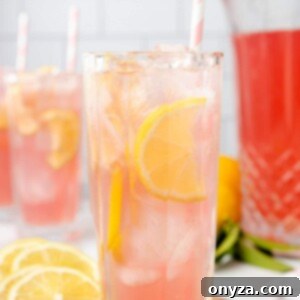
Pink Lemonade
This beautiful and refreshing Pink Lemonade gets its delightful pastel color from natural cranberry juice. With just 4 ingredients, it’s incredibly easy to make and fully customizable to your personal preferences. It’s an excellent choice for any gathering, from spring and summer picnics to brunches and showers!
Ingredients
- 1 cup freshly-squeezed lemon juice *
- ¾ to 1-1/4 cups granulated sugar **
- ½ cup cranberry juice or Cran-Raspberry juice
- 4-1/2 to 5 cups filtered or spring water, chilled ***
Instructions
- In a large pitcher, combine the lemon juice and granulated sugar. Whisk vigorously until combined. Let the mixture stand for 5 minutes, then whisk again to ensure the sugar is fully dissolved.
- Pour in the cranberry juice and chilled water. Stir everything well to combine all ingredients thoroughly.
- Place the pitcher in the refrigerator and chill the lemonade for at least one hour before serving.
- Before serving, stir the lemonade again. Pour it into ice-filled glasses and garnish with fresh lemon wedges. This homemade Pink Lemonade can be stored, covered, in the refrigerator for up to 4 days.
Notes
- * If you prefer your lemonade completely smooth and pulp-free, strain the freshly squeezed lemon juice through a fine-mesh sieve before adding it to the pitcher.
- ** The amount of sugar needed will vary based on your personal preference for sweetness and the type of cranberry juice you use. Unsweetened 100% pure cranberry juice is quite tart and will require more sugar. Cranberry juice cocktail and most blends (even 100% juice varieties) are typically sweeter. My family generally prefers a sweeter lemonade, so I usually use ¾ to 1 cup of sugar, especially when using Cran-Raspberry juice. For more details on choosing your cranberry juice, refer to the “Choosing the Cranberry Juice” section above.
- *** The water quantity also depends on your desired concentration. For a slightly more intense lemonade that will dilute gracefully with ice in the glass, use 4-1/2 cups of water. For a milder pink lemonade from the start, opt for 5 cups. Taste and adjust as needed.
Nutrition Estimate
Serving: 8 ounces | Calories: 115 kcal | Carbohydrates: 30g | Protein: 1g | Fat: 1g | Saturated Fat: 1g | Polyunsaturated Fat: 1g | Monounsaturated Fat: 1g | Sodium: 5mg | Potassium: 59mg | Fiber: 1g | Sugar: 29g | Vitamin A: 12 IU | Vitamin C: 18mg | Calcium: 7mg | Iron: 1mg
Nutrition information is automatically calculated and should be used as an approximation.
Please note that our recipes have been developed using the US Customary measurement system and have not been specifically tested for high altitude/elevation cooking and baking adjustments.
Enjoyed this recipe? Please rate and leave a comment below!
Your feedback helps others discover delicious recipes.
